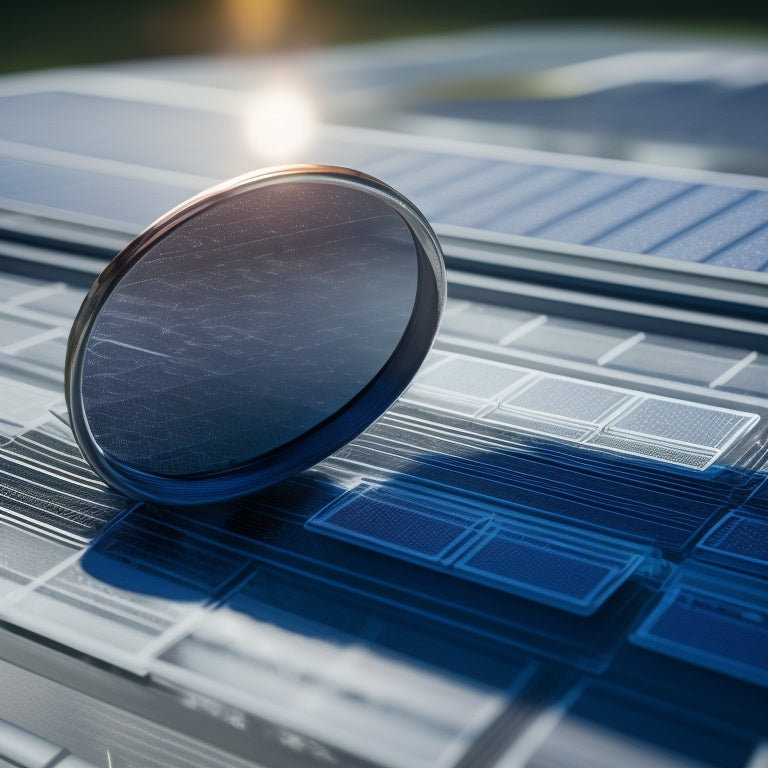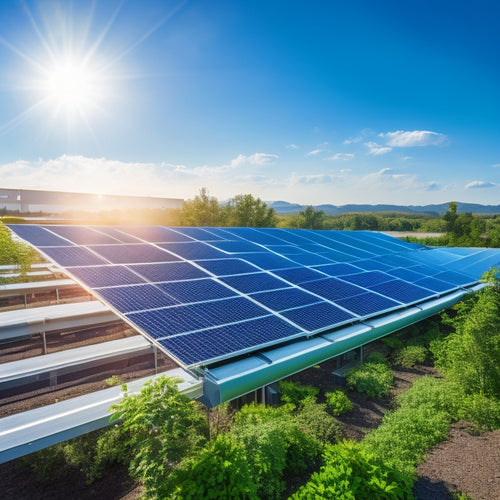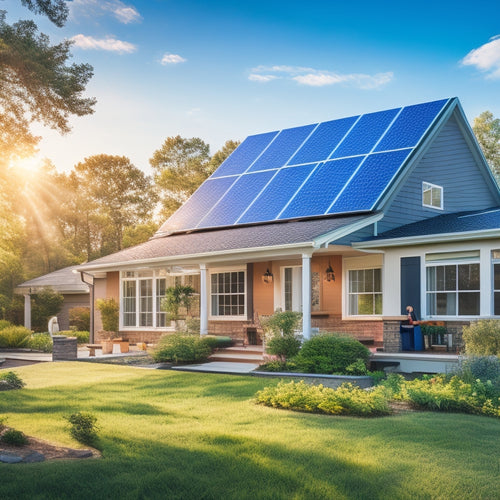
A Step-by-Step Guide to Solar Panels Price Per Panel
Share
When evaluating solar panels, you need to reflect on the complex mix of equipment quality, installation costs, financing options, and government incentives that determine the overall price per panel, with a typical installation costing between $2.50 to $3.50 per watt in the US market. The cost per watt is essential, as it's affected by panel quality, installation location, and financing options. Understanding these factors, as well as the different types of solar panels and their prices, will help you calculate the total cost of ownership. Now, you're ready to explore deeper into the world of solar panels and uncover the best option for your energy needs.
Key Takeaways
- The cost of solar panels varies depending on equipment quality, installation costs, and financing options, making a thorough cost assessment crucial.
- High-quality solar panels with superior materials and advanced manufacturing processes significantly impact overall cost, with higher-efficiency panels yielding more power but at a higher cost.
- The cost per watt metric is essential for evaluating solar system affordability, calculated by dividing total cost by total wattage, with higher-efficiency panels leading to lower cost per watt.
- Average installed costs of solar panels in the US range from $2.50 to $3.50 per watt, with incentives and rebates able to significantly lower the net cost of installation.
- Financing options, including loans, leases, and power purchase agreements, can increase affordability, with the Solar Investment Tax Credit (ITC) able to reduce upfront costs by up to 26%.
Understanding Solar Panel Pricing
When evaluating solar panels, understanding the pricing structure is essential to making an informed decision. You're not just buying a product; you're investing in a system that will generate electricity for years to come. The cost of solar panels varies depending on the type and quality of the equipment, installation costs, and financing options.
You'll need to assess the upfront cost of the system, as well as ongoing expenses like maintenance and repairs.
Fortunately, government incentives like the Solar Investment Tax Credit (ITC) can help offset the initial investment. This credit allows you to claim a percentage of the total cost as a tax credit, reducing your federal income tax liability. Additionally, many states and utilities offer rebates and other incentives to encourage the adoption of solar energy.
Financing options are also available to help make solar more accessible. You can choose from loans, leases, or power purchase agreements (PPAs), each with its own advantages and disadvantages.
Factors Affecting Solar Panel Cost
You'll find that the cost of solar panels varies greatly depending on the quality of the panels themselves, with high-efficiency panels typically coming at a premium.
Where you choose to install your solar panel system also plays a major role in determining the overall cost, as installation costs can differ considerably depending on the location.
As you consider your solar panel options, it's crucial to understand how these factors will impact your bottom line.
Panel Quality Variance
Solar panels' quality greatly impacts their cost, and understanding the factors that contribute to this variance is essential for making an informed purchase decision.
You'll find that high-quality panels are more expensive due to their superior materials, advanced manufacturing processes, and rigorous testing. One key aspect is panel efficiency, which measures how well a panel converts sunlight into electricity. Higher-efficiency panels produce more power per unit area, making them more desirable and costly.
Warranty options also play a significant role in panel quality variance. Reputable manufacturers offer longer warranties, often up to 25 years or more, which raises their product's cost. You'll need to weigh the benefits of a longer warranty against the additional upfront expense.
Additionally, premium panels may feature advanced technologies like bifacial cells, which capture light from both sides of the panel, further enhancing their efficiency and price.
Installation Location Impact
Beyond panel quality, the location where you install your solar panels greatly affects their overall cost.
You'll find that rural installations often come with higher costs due to longer distances between the installation site and the nearest utility grid. This increases the need for longer cable runs, more complex electrical infrastructure, and potentially even additional permits.
In contrast, urban considerations typically involve shorter cable runs, easier access to existing infrastructure, and fewer permitting obstacles. As a result, urban installations tend to be more cost-effective.
Additionally, urban areas often have higher property values, which can lead to increased demand for solar panels and economies of scale for installation companies, further driving down costs.
When planning your solar panel installation, it's important to factor in the specific challenges and benefits associated with your location to get an accurate estimate of the total cost.
Types of Solar Panels and Prices
You'll encounter two primary types of solar panels on the market: monocrystalline and thin film.
Monocrystalline solar panels are made from high-purity silicon crystals, offering higher efficiency rates and a longer lifespan.
Thin film solar panels, on the other hand, are composed of multiple thin layers of photovoltaic material, providing a more affordable option with lower efficiency rates.
Monocrystalline Solar Panels
Across the range of photovoltaic technologies, monocrystalline solar panels stand out for their exceptional efficiency and reliability. You'll find these high-performance panels in many residential and commercial installations.
Monocrystalline efficiency typically ranges from 15% to 20%, markedly higher than other types of solar panels. This means you'll generate more power per hour of sunlight, making them an excellent choice for rooftops with limited space.
Monocrystalline lifespan is also impressive, with a typical warranty of 25 years or more. You can expect these panels to maintain their performance for decades, providing a reliable source of clean energy.
The higher upfront cost of monocrystalline solar panels is offset by their superior efficiency and longer lifespan. When calculating the cost per watt, monocrystalline panels often become a more cost-effective option in the long run.
As you weigh your solar panel options, consider the benefits of monocrystalline technology for your energy needs.
Thin Film Solar Panels
In contrast to monocrystalline solar panels, thin film solar panels employ a distinct photovoltaic technology that sets them apart from other types of solar panels.
You'll notice that thin film solar panels are made by depositing a thin layer of photovoltaic material on a substrate, typically glass or plastic. This process allows for a more flexible and lightweight design.
Thin film solar panels offer several advantages, including:
- Lower production costs: Thin film technology is cheaper to manufacture, making it a more affordable option.
- Flexibility and durability: Thin film panels are more resistant to cracking and can withstand harsh environmental conditions.
- Better performance in low-light conditions: Thin film panels perform better in low-light conditions, making them ideal for areas with limited sunlight.
- Eco-friendly: Thin film panels require less energy to produce and have a lower carbon footprint compared to traditional solar panels.
- Thin film efficiency: While thin film panels have lower efficiencies (around 7-14%), they're still a viable option for those looking for a cost-effective solution.
Keep in mind that thin film advantages come with some trade-offs, such as lower power output and a larger required surface area.
However, if you're looking for a budget-friendly option with decent efficiency, thin film solar panels might be the way to go.
Calculating Solar Panel Cost Per Watt
Calculating solar panel cost per watt is an essential step in evaluating the affordability and efficiency of a solar panel system. You need to take into account the cost per watt to determine the overall cost of the system and its potential to generate renewable energy benefits.
To calculate the cost per watt, you'll need to know the total cost of the solar panel system and its total wattage. Divide the total cost by the total wattage to get the cost per watt. For instance, if the total cost is $15,000 and the total wattage is 5,000 watts, the cost per watt would be $3 per watt.
Solar panel efficiency also plays a significant role in determining the cost per watt. Higher-efficiency panels produce more power per unit area, resulting in a lower cost per watt.
When evaluating solar panels, look for those with high efficiency ratings to get the most bang for your buck. By taking into account the cost per watt and solar panel efficiency, you can make an informed decision about the best solar panel system for your needs.
Average Cost of Solar Panels Installed
What's the bottom line when it comes to installing solar panels? You're likely wondering how much you'll need to pay to get started with renewable energy. The average cost of solar panels installed can vary depending on several factors, including the size of your system, the type of equipment, and the installation company you choose.
Here are some key considerations to keep in mind:
-
The total cost of installation can range from $15,000 to $30,000 or more, depending on the size of your system.
-
Government incentives, such as the Solar Investment Tax Credit (ITC), can help reduce the upfront cost by up to 26%.
-
Financing options, like loans or power purchase agreements, can make solar more affordable and accessible.
-
The cost per watt of your solar panel system can impact the overall price, with higher-efficiency panels typically costing more.
-
Installation costs, including labor and equipment, can account for a significant portion of the total cost.
Solar Panel Price Comparison Chart
Frequently, homeowners find themselves overwhelmed by the numerous solar panel options available in the market. To make an informed decision, you need a clear comparison of the prices and features of different solar panels.
A solar panel price comparison chart is an essential tool to help you narrow down your options. This chart allows you to compare the prices of various solar panels per watt, their efficiency, and warranty periods. You can also use the chart to evaluate the different financing options available, such as loans, leases, and power purchase agreements, and determine which one suits your budget.
Additionally, the chart can help you identify the solar incentives you're eligible for, such as federal and state tax credits, rebates, and grants. By analyzing the chart, you can identify the most cost-effective solar panel option that meets your energy needs and budget.
With a clear comparison of prices and features, you can make an informed decision and invest in the right solar panel system for your home.
Negotiating the Best Solar Deal
When you've narrowed down your solar panel options, it's time to negotiate the best deal. You've done your research, compared prices, and now it's time to get the most out of your investment.
To negotiate effectively, consider the following:
-
Don't be afraid to walk away: If the deal isn't sweet enough, be willing to walk away. This shows the seller you're not desperate, and they may be more willing to compromise.
-
Know your financing options: Understand the various financing options available, such as loans, leases, and power purchase agreements. This will give you more bargaining power.
-
Take advantage of tax incentives: Make sure you understand the tax incentives available, such as the federal solar investment tax credit (ITC). This can greatly reduce the upfront cost of your solar panels.
-
Look for bundle deals: If you need other energy-efficient upgrades, such as a new roof or energy-efficient windows, ask if the seller can offer a bundle deal.
-
Get everything in writing: Make sure all agreements, including warranties and maintenance contracts, are in writing and clear to avoid any misunderstandings.
Frequently Asked Questions
Can I Install Solar Panels Myself to Save Money?
You can attempt a DIY installation to save money, but consider the risks: improper installation can void warranties, compromise system efficiency, and even pose safety hazards, potentially offsetting any initial cost savings.
Are There Any Solar Panel Brands Made in the Usa?
You're looking for solar panel brands made in the USA, and you'll find some superior options. Companies like SunPower, Tesla, and CertainTeed manufacture high-efficiency panels using advanced manufacturing processes, ensuring quality and reliability in their products.
Do Solar Panels Work Well in Cloudy or Shaded Areas?
You'll find that solar panels don't perform as well in cloudy or shaded areas, as shading impact reduces solar efficiency. Even partial shading can decrease energy output, but you can mitigate this with clever system design and panel placement optimization.
Can I Add More Solar Panels to My Existing System?
You're not stuck with your initial setup - you can upgrade! Adding more solar panels to your existing system is possible, but first, you'll need to check compatibility and assess system expansion feasibility to guarantee a seamless integration.
Are Solar Panels Covered Under a Home Warranty?
You're wondering if solar panels are covered under a home warranty? Typically, they're not, but some manufacturers offer a solar warranty. Review your policy's coverage details to determine if repairs or replacements are included, and what's excluded.
Conclusion
As you stand at the threshold of utilizing the sun's energy, the path ahead is illuminated by the knowledge you've gained. With each step, the puzzle pieces of solar panel pricing fall into place, revealing a clearer image of what to expect. Now, armed with this all-encompassing guide, you're ready to negotiate the best deal, like a navigator charting a course through calm waters, and unleash the full potential of solar energy for your home or business.
Related Posts
-

Energy-Efficient Lighting Solutions for Sustainable Buildings
For sustainable buildings, energy-efficient lighting solutions, like LEDs, offer multiple benefits. These bulbs last ...
-

Solar Energy Efficiency Improvements for Businesses
Improving solar energy efficiency for your business can lead to considerable cost savings and enhance your sustainabi...
-

Solar Energy Grants and Incentives for Homeowners
Maneuvering solar energy grants and incentives is essential for reducing your installation costs. You can benefit fro...


